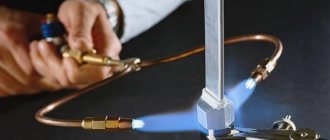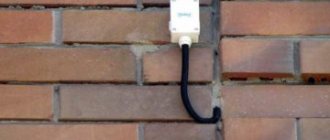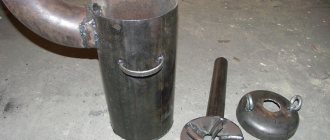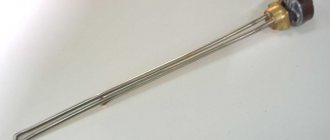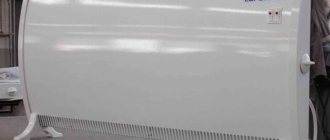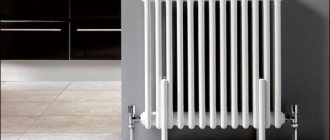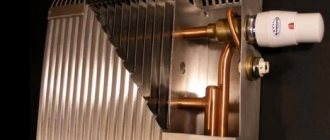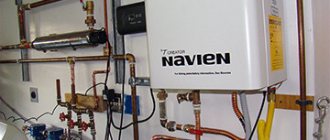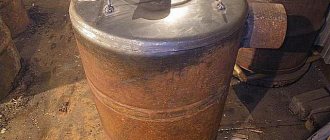Temperature sensors are used in many industrial and other processes, and today they are one of the most popular measuring instruments. In this article I would like to talk about the classification of temperature sensors, features of various types, and connection diagrams.
As the name implies, the main task of sensors of this type is to monitor the temperature of a wide variety of objects. This includes air temperature, the temperature of various liquids, gases, solids and much more. Due to the demand for temperature measurements, they are widely used in a variety of areas - from process automation control systems to applications in the domestic sector.
Despite all the differences and application features, the operation of all temperature sensors is based on the principle of converting the measured temperature into an electrical signal. But what kind of signal it will be depends directly on the type of sensor.
Sensor structure and operation
The temperature sensor measures pressure, expansion, resistance, which are dependent on the temperature within a certain range. If the thermostat is automatic, then all the formulas are included in the working program.
The device is simple, consists of a small case with fasteners, and a sensor is built inside. It can be sealed or open, with or without wires.
Basically, the device contains a temperature-sensitive liquid or metal. When heating occurs, the liquid begins to expand, and metal parts create resistance. All information goes to the automation system, where the boiler combustion is adjusted. The thermostat, turning the boiler on and off, creates its operating mode.
Signs of breakdown
Like malfunctions of any device in a car, failure of the coolant temperature sensor can lead to undesirable consequences.
When the car is moving, a breakdown may manifest itself as:
- problematic engine starting in cold weather;
- atypical sounds from the exhaust gases when the engine is running;
- when the maximum temperature is reached, the motor stalls;
- The cooling fan does not start when the internal combustion engine heats up;
- excess fuel consumption above the established norm.
Modern cars display data on coolant temperature violations on the display. The cause of the malfunction can be either mechanical failure (broken threads, cracking of the case, burnt out thermistor) or electrical failure (short circuit in the measuring circuit or broken wire). To make sure your assumption is correct, check the sensor and, if necessary, replace it with a new one.
Grouping of temperature sensors
When choosing a device, you need to decide where it will stand and monitor the temperature. This could be inside the boiler, in the heating system or in the room.
The correct operation of the heating system will depend on the choice.
Temperature sensors can be divided into several categories:
- By temperature determination method;
- By the way the interaction with the thermostat occurs;
- According to accommodation options.
How to install the Starline car alarm version A91?
It is possible to equip a car with the Starline A91 security system if the battery has a voltage of 12 Volts and a negative plus on the body itself.
The location of the central unit should be in a hidden area of the cabin. It is best to place it right where the dashboard is located, or rather under it. In this situation, the length of the connecting wires will be short. In order to prevent liquid from entering the central unit, you should integrate it so that drops of water cannot flow down the wiring into the inside of the housing. First, you will have to secure the central type block to a horizontal surface using self-tapping screws or double-sided tape. This will be necessary to prevent the block from moving during vibrations.
Types of temperature-detecting devices
There are several categories of sensors that indicate the temperature of the heating system:
- Dilatometric in the form of a spiral or bimetal plate, they work on the principle of expansion of metal elements;
- Resistive, depend on changes in electrical resistance, responding to all temperature changes in a specific interval;
- Thermoelectric ones are made of alumel-chromel; at certain temperature conditions, a thermocouple is activated;
- Gauge gauges react to changes in liquid or gas pressure in a confined space.
Thermostatic control valves
The thermostatic valve is a simple solution to the problem of obtaining a coolant at a given temperature by mixing colder water with warmer water. The three-way valve is shown below:
Three-way valve
Scheme for connecting a three-way valve to the heating system:
Scheme for connecting a three-way valve to a heating system
Types of sensors for contact with the thermostat
Sensors that measure temperature interact with a device that maintains the temperature in one mode. These meters can be divided into two types:
- Wired, when the temperature sensor is connected to the boiler using wires;
- Wireless operate by transmitting information via radio frequencies.
Calibrations
Fixed point tuning is used to obtain the highest accuracy by national metrology laboratories.
It uses the triple point, the freezing or melting point of pure substances such as water, zinc, tin and argon, to create a known and repeatable temperature. These cells allow the user to reproduce actual conditions on the ITS-90 temperature scale. Fixed point calibration provides extremely precise adjustment (within ±0.001°C). A common fixed-point calibration method for industrial sensors is the ice bath. The equipment is inexpensive, easy to use, and can accommodate multiple sensors simultaneously. The ice point is designated as a secondary standard because its accuracy is ±0.005 °C (±0.009 °F) compared to ±0.001 °C (±0.0018 °F) for the primary fixed points.
Comparative calibrations are commonly used with secondary SPRTs and industrial RTDs. Calibrated thermometers are compared with tuned resistance thermometers using a bath whose temperature is uniformly stable.
Unlike fixed-point calibration, comparison can be made at any temperature from −100 °C to 500 °C (–148 °F to 932 °F). This method can be more cost-effective because multiple sensors can be calibrated simultaneously using automatic equipment. These electrically heated, well-mixed water baths use silicone oils and molten salts as a medium for varying temperature settings.
Accommodation options
Thermal sensors can be installed in different places; they can also be divided into several groups:
- Overlays are attached tightly to the surface, which is heated;
- Submersible units are installed directly with the coolant;
- Room ones that measure ambient temperature;
- External, used for installation outside the premises.
Correct operation
When operating temperature sensors, the instructions of the boiler and measuring device manufacturer must be strictly followed. In order to ensure the accuracy of measurements, the sensitive element must have the greatest contact with the medium being measured; in addition, it will be necessary to promptly maintain the measuring device and calibrate it within the time limits indicated in the instructions.
Specifics of diesel engine operation in compliance with safety regulations:
- The diesel engine is installed in the environment that must be controlled and regulated by heat exchange;
- during installation, all negative factors that could change the sensor reading must be excluded;
- It is prohibited to operate the meter with damaged insulation;
- It is forbidden to disassemble the sensor yourself;
- All repair and maintenance operations are performed with the meter's networks completely disconnected from the 220V voltage.
Connecting a temperature sensor
Whatever type of temperature meters they are connected to a thermostat or other control controller. Before operation, you should read the user manual to become familiar with the parameters and requirements needed to install the device.
Experts advise choosing sensors recommended by the manufacturer.
Malfunctions
High-temperature operating conditions of the sensors, especially during unstable boiler operating conditions, lead to the fact that the primary meters fail. The boiler will often shut down if the thermocouple fails periodically, or diagnostics of the boiler operation will signal an error, and the instruments may show an “open circuit.”
Steps to troubleshoot a faulty temperature sensor:
- To repair the diesel engine, I check the correctness of the -ve and + ve conclusions
- I make sure that the cable is installed in accordance with the manufacturer's recommendations.
- I check that there are no external heat sources that could distort the DT readings.
- I check the temperature regulator setting.
- I diagnose possible interruption errors.
- I inspect the sensor for damage.
- I check the faulty thermocouple with a multimeter.
The temperature sensor is the main meter in the boiler safety and control system. It not only performs a protective function, but also contributes to up to 30% savings in thermal energy and gas consumption, since it does not allow overheating and boiler cycling.
Modern Russian requirements for the operation of household boilers oblige all boiler manufacturers to install diesel engines in the safety and protection system; it is better if this work is performed directly at the factory.
Connecting an outdoor device
The connection diagram for an outdoor temperature sensor is simple, but requires certain conditions to be met:
- The sun's rays should not fall on the device;
- A non-metallic wall surface for fastening is required;
- The sensor is hung at a height of 2/3 of the building level;
- For accurate operation without interruptions, it is necessary to exclude the effect of aggressive environments and negative factors on the device;
- Do not lay the cable in damp places.
When running a cable along the street, it is necessary to place the wire in a corrugation. When connecting parts, care must be taken; work must be done with the power supply to the equipment turned off.
How to choose?
When choosing a temperature sensor, you must be guided by the following criteria:
- if the sensor is in contact with or located inside the measured medium, then a contact model is taken, if it is located outside the object, then a non-contact model;
- the conditions and state of the environment in which it will operate (humidity, aggressive substances, etc.) must correspond to the capabilities of the sensor;
- the step and calibration of measurements should ensure convenient operation of both the sensor and the equipment;
- if the sensor must be replaced during operation, then replacement options are installed;
- when choosing a temperature sensor to replace a faulty one, it is better to use its VIN code;
- The operating temperature limit must cover all possible heating values, some of which are shown in the table below.
Table: temperature limits of thermoelectric type sensors
| Type | Compound | Temperature range |
| T | copper/constantan | -250 °C to 400 °C |
| J | iron/constantan | -180°C to 750°C |
| E | chromel/constantan | -40 °C to 900 °C |
| K | chromel / alumel | -180 °C to 1,200 °C |
| S | platinum-rhodium (10%) / platinum | from 0 °C to 1,700 °C |
| R | platinum-rhodium (13%) / platinum | from 0 °C to 1,700 °C |
| B | platinum-rhodium (30%) / platinum-rhodium (6%) | from 0 °C to 1,800 °C |
| N | nichrosil / nisil | -270 °C to 1,280 °C |
| G | tungsten / rhenium (26%) | from 0 °C to 2,600 °C |
| C | tungsten-rhenium (5%) / tungsten-rhenium (26%) | from 20 °C to 2,300 °C |
| D | tungsten-rhenium (3%) / tungsten-rhenium (25%) | from 0 °C to 2,600 °C |
Connecting the sensor indoors
To measure room temperature, the meter is mounted on the inside of the building.
The location is selected according to the following parameters:
- There was free access to the sensor;
- There were no devices that produced heat or cold;
- It was at a height of one and a half meters from the floor;
- There were no powerful electrical devices emitting electromagnetic waves nearby.
The sensor can be mounted on a wall or in a recess, but it must be open from the outside.
Varieties
Among the popular brands/models of fire and security sensors on the market, the following products should be highlighted (at the time of writing):
- IP 22051TEI-63-IV is a model of an addressable analogue combined (heat/smoke) detector from the Sphere of Security enterprise. Protection area – 176 sq. m. Dimensions – diameter 102 mm, height 61 mm, weight only 88 g.
- IP 212/101-Bark is a combined detector with heat and smoke sensors combined in one housing. Manufacturer: NPO PAS. Power supply via AL 24 V. Protection – IP Operating temperature range – from – 30 to + 55℃. The maximum number of detectors in the AL is 63 pcs. Dimensions – diameter 100 mm, height 78 mm with a weight of 0.2 kg, which does not exceed the dimensions and weight of a traditional optical smoke detector.
- There are also product models under the abbreviation IP 212/101 from other manufacturers - this is ECO1002, also known as IP 212/101-2-A1R from; IP 212/101-11-PR from ; "Aurora-DTR" (IP 21210/10110-1-A1) from the manufacturer "Argus-Spectrum", operating via a radio channel with a control panel at a range of up to 600 m, as well as a number of other enterprises with similar technical characteristics.
- “S2000-IPG” is a combination of a gas sensor, which determines the content of carbon monoxide in the air, and a maximum differential thermal sensor, combined in a compact housing of an addressable analogue fire detector, the dimensions of which are 100 mm in diameter and 47 mm in height. Power supply: 12 V. Installation type: ceiling. In production.
- IPK-3.3/IPK-3.5 – four- and two-wire combined (smoke/heat) detectors from Ukrainian, operating on a 12/24 V alarm loop.
- MSD-300 is a radio channel combined smoke and heat detector, TSD-1 is a similar device, with 12 V power supply via an alarm loop from Satel from Poland.
- Panasonic 4400 is a multi-sensor smoke detector that, thanks to automatic settings, can be installed in clean, smoky, and hot rooms.
- "Sokol-2" is a combined security detector designed to detect illegal access to enclosed spaces. Its official abbreviation is IO 414-1. It implements double control of the volume of protected space according to two parameters - IR/microwave, i.e. registration of changes in IR radiation after a person crosses control zones formed by an optical sensor, as well as changes in the electromagnetic field created by a microwave sensor. When triggered in any sequence, they generate an alarm by opening the output relay contacts. Range – 12 m. Installation method – wall-mounted. Dimensions – 135x70x50. Can be used at temperatures from – 30 to + 50℃.
- “Sokol-3” is a model of a similar IR/microwave volumetric security detector, designed for installation on the ceiling of a protected room. Dimensions – diameter 90 mm, height 35 mm. The detection range of the sensors is 5 m. Both security detectors are produced domestically.
- The family of security and radio-channel fire detectors with the Astra trademark is a Russian product. Among them are combined IS: “Astra-551” – IR/radio wave security detector with a range of 10 m, detection zone angle 90; "Astra-641" - with an IR/ultrasonic sensor.
The choice is quite large, there are no problems choosing a combined fire and security detector, incl. one manufacturer; because Leading companies that manufacture fire alarm systems, as a rule, produce lines of models of both types, which ensures ease of design using ready-made circuits, full compatibility, reliability of equipment operation, reduced energy consumption, and simplified installation work.
Types of combined fire detectors
Why is a boiler sensor needed?
Modern heating equipment is equipped with elements that contribute to the efficient use of energy resources:
- Electric heaters are designed to produce infrared radiation with high efficiency;
- In gas heating boilers, a system for regular flame monitoring is built in, optimizing the entire process;
- Boilers with solid fuels have various chambers built into them where processed products are removed.
If there is no correct heat flow, optimal use of fuel and electricity will not be beneficial. This will require some conditions for creating individual components. This is where a temperature regulator becomes necessary.
Proper use of equipment produces such positive aspects as:
- Autonomous temperature maintenance mode;
- Saving heating costs up to 30 percent;
- It is possible to remotely adjust modes;
- The service life of the boiler is extended.
Adviсe:
- Before buying a boiler, you should measure the room and calculate the required air temperature, so that there is no downtime due to modifications to the heating system.
- It is necessary to insulate a house or apartment before installing equipment to avoid heat losses.
- To begin with, you can buy an inexpensive sensor, test it in operation, maybe it will work great.
Temperature meters are easy to select and install. The main thing is to follow the proposed instructions and carry out all the steps in the work step by step.
Purpose
The need to use sensors that monitor temperature parameters may arise in various situations. These universal devices are used everywhere in enterprises where the stability of temperature parameters can harm the quality of products or affect the technical characteristics of the equipment in use.
They are actively connected at enterprises of the oil and gas and energy complex, ensuring the implementation of technological processes in foundries, machine-building, rolling production, in the manufacture of metal structures and mechanical processing. They are indispensable in the transport industry, food industry enterprises, pharmaceuticals, and agriculture.
And with their help:
- controls the course of chemical reactions;
- scientific research is carried out;
- the degree of heating of the processed product is maintained within a given range;
- optimal temperature parameters are maintained in various nodes of road and rail transport;
- the necessary conditions are created for grain processing and feed production;
- the temperature of a specific object is measured with a given accuracy;
- Feedback is implemented, thanks to which it is possible to avoid premature equipment failure.
Attention! Thermocouples can not only be used to control temperature, but also act as a source of energy.
Photo of temperature sensor connection
What wire can be used to connect room thermostats?
Another important point in connecting the thermostat is the choice of wire. Typically, the cross-section and number of cores are indicated in the instructions for a specific product. In addition, you need to remember the distance from the thermostat to the boiler or hub to which the thermostat is connected - if the output on the thermostat is potential, then the length of the wire can have a significant impact on the operation of the automation. This is due to the voltage drop on the wire. To reduce it, you should take a wire with the largest possible cross-section.
Most often, to connect mechanical thermostats, a two-core wire with a cross-section of 0.5 or 0.75 “squares” is used . For electronic ones, as I described above, it is important to consider the length of the wire. The longer the wire, the larger the cross-section should be (usually the cross-section does not exceed 1.5 “squares”) . But manufacturers do not recommend exceeding the wire length of 100 meters, although this is not specified in the data sheets and instructions for the products.

